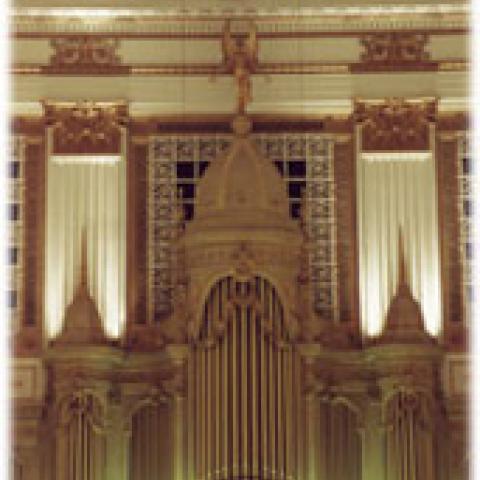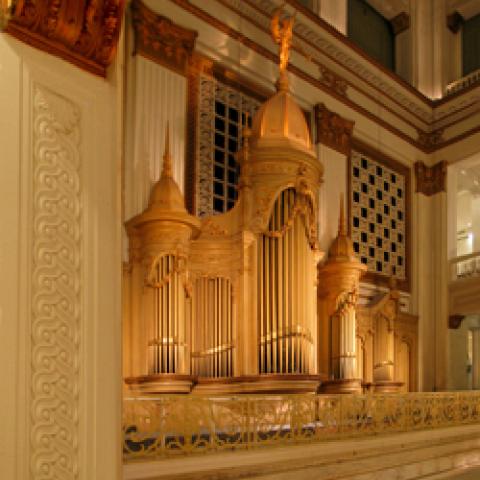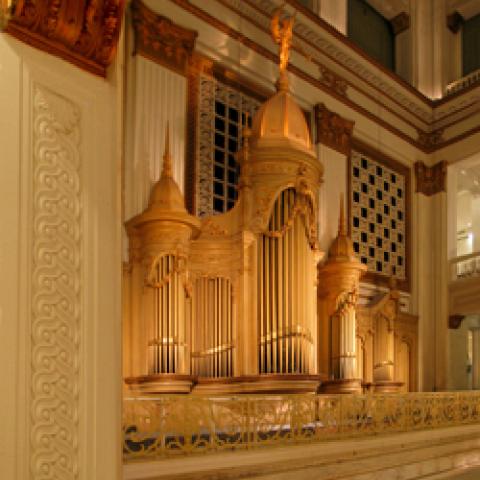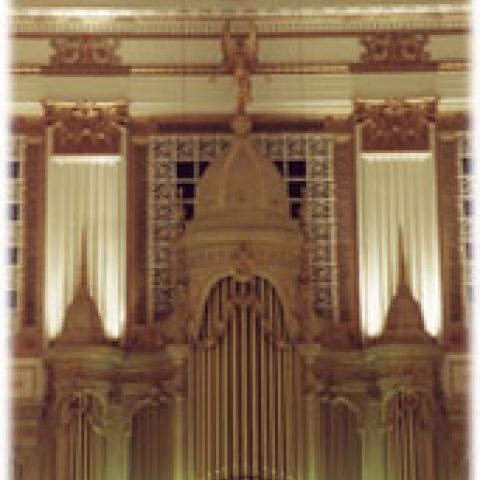A new radio show, The Wanamaker Organ Hour, airs on the first Sunday of each month, at 5 PM (EST). Listeners can tune into a live streaming audio over Internet radio at WRTI.ORG. Hosts are Peter Richard Conte, Wanamaker Grand Court Organist, and WRTI's Jill Pasternak.
Wanamaker Organ Hour debuts in streaming audio
Related Content
In the wind . . .

Size matters, part two
First assignment: Please reread In the wind . . . in the May issue of The Diapason. Thank you.
Robin Hall is a very cool man. I met him in his office on West 34th Street in New York late on a February afternoon. A two-foot model of Sponge Bob Square Pants hangs from the ceiling. Kermit the Frog sits on the desk next to a DVD of Miracle on 34th Street. The walls are painted Wasabi Green. Kermit clashes with the walls—It isn’t easy being green. There’s a rack of file folders on a shelf under the window behind his desk—the folders are bright orange, obviously chosen to complement the walls. A snappy haircut, stylish eyeglass frames, and a breezy enthusiastic manner complete the picture.
Mr. Hall is a vice president for Macy’s department stores, and his office is in Macy’s flagship store on Herald Square. He heads the company’s department of Annual and Special Events. While I expect some department stores consider inventory to be the height of annual events, when you think of Macy’s you think of the Thanksgiving Day Parade. The department employs about 50 people who produce the parade, in-store flower shows, and public fireworks displays, to name a few activities. The hanging Sponge Bob is a sculptor’s model for a huge parade balloon. A few blocks away, there’s a parade studio with welders, woodworkers, and the cadre of artisans needed to build the floats and balloons for the parade, the artsy little bridges and gazebos that are installed in the store for flower shows, and all the other gizmos and gadgets that are the products of this unique division.
When I observed that he has a dream job, Robin pointed through the wall to the guy in the next office saying, “he’s the one with the great job.” He’s the one who interviews, reviews, auditions, and coordinates the high-school bands that travel to participate in the parade each Thanksgiving. You might think that job to be a nightmare of logistics, cancellations, and odd requests from hundreds of people, but Robin referred to the huge excitement of the many families traveling to New York so their kids could march in the great televised parade. Attitude matters.
Our conversation was about an hour long, ebullient, rocketing from one thing to another. At one point Robin said, “. . . more than in many other facets of modern life, passion is common in my world. I’m surrounded by passionate people doing the things they are passionate about.” (See Photo 1: a disinterested listener.)
Wouldn’t it be great if someone like this were in a position of responsibility for the care and promotion of a monumental public pipe organ?
A few years ago Macy’s merged with Federated Department Stores. The new company spun off Lord & Taylor. Lord & Taylor moved out, and Macy’s moved into a grand building on Market Street in Philadelphia, originally built by John Wanamaker to house his legendary department store, which included just that monumental public pipe organ. That’s right—the people who produce the Macy’s Parade are in charge of the Wanamaker Organ.
Last month I wrote about the history of that iconic instrument, hence the assignment for rereading. This month I share my reflections after spending 36 hours with the organ and the people around it. It was organ curator Curt Mangel who told me about Macy’s hearty support of the organ. Curt encouraged me to get in touch with Robin Hall; that referral led to my interview with him. Robin told me that when Macy’s acquired the Wanamaker properties, Melissa Ludwig, regional director of Macy’s Stores for the Philadelphia area, “sent an e-mail around” that described the relevance and reputation of the Wanamaker organ and in effect encouraged store management to be aware of the importance of the stewardship of the organ.
Robin Hall told me much about the importance of music in Macy’s heritage. He described an upcoming concert at Carnegie Hall, A Tribute to Macy’s, which would include newly commissioned songs. Each of the 80 versions of the Macy’s Parade has been a major musical event. For 40 years Macy’s has produced the July 4th fireworks on the New York waterfront in collaboration with the New York Pops Orchestra. Live music is considered an important part of any Macy’s event. Robin told me, for example, that the East Village Opera Company would be performing at upcoming corporate meetings. Special events are not a marketing tool, but central to the company’s mission. Attractions like the parade and flower shows are assets to retail activity and an opportunity for Macy’s to give back to the community. Simply put, Macy’s has always believed that music and theater are an essential part of the shopping experience. Special events enhance the brand. And emotionalism is “almost a religion.” How’s that for a corporate priority?
As Macy’s has long been devoted to musical and artistic extravaganzas, what better organization to have responsibility for the world’s greatest musical instrument? I was told how the Wanamaker Organ was a perfect fit into the portfolio of the Special Events Division, that it would “have a natural place in the Macy’s method.” Plans are under way to feature the organ in new types of programs and to enhance the listening experience in the Grand Court. And beyond mere enthusiasm is considerable tangible support. In its first years of stewardship of the organ, Macy’s has committed to the design and purchase of a new Peterson combination action (remember, there are 462 stop-tablets and 167 pistons!) and to the refinishing of the massive ornamented case of the six-manual console.
My hour in Robin Hall’s office was inspiring—how thrilling to hear of a major retail corporation wholeheartedly involved in arts and culture. It was fun—Robin is a compelling and engaging person. And it was encouraging—we live in a world dominated by bad news, in a culture that celebrates mediocrity, and my heart was warmed by the enthusiasm emanating from a corporate office in Manhattan in support of an organ in Philadelphia.
But the real thrill that day was to hear Robin talk about Peter Richard Conte, the Grand Court Organist, and L. Curt Mangel III, the curator of the organ. Robin spoke of how Peter understands the mission of the organ, that he is a serious, exceedingly skillful classical musician who knows how to balance high culture and popular populist selections, and who has a highly developed sense of fun. He spoke of Curt’s deep dedication to his work, his technical and organizational skills, his encyclopedic understanding of the instrument, and the work of keeping it in good condition. (See Photo 2: Peter Richard Conte [aka The conjurer].)
Peter Richard Conte has been Grand Court Organist at the Wanamaker Store since 1989. The hundreds of concerts he’s played at the store—along with his active touring schedule—make him one of America’s most experienced performers. In addition to what must be dozens of hours at the keyboard each week, Peter is both skilled and prolific at transcribing major orchestral repertory for his performances. His neat large-format manuscripts are peppered with colored dots indicating registration changes—the preparation time is obvious. I felt privileged to stand next to Peter while he played a noontime recital that included the “Immolation Scene” from Richard Wagner’s Götterdämmerung, César Franck’s Choral in A minor, and Robert Hebble’s intricate and sexy Danny Boy (melody in the pedal, accompaniment packed with the “ten dollar chords” described in Ted Alan Worth’s rambling, moderately literate, intensely personal recollections of Virgil Fox in The Dish). The console is bewildering. I’ve mentioned 462 stop-tablets, but you have to see it to appreciate it. There are eleven expression pedals and six keyboards. Peter’s hands are just like everyone else’s except they each have eight telescoping fingers and each finger has three knuckles that are not double but universally jointed. He flies through the most complicated passages with apparent ease, the observer having hardly a chance of comprehending the relationship between the printed score and what’s happening on the keyboards.
It sounds like a parlor trick, but it’s so much more. While the symphony orchestra comprises dozens of separate voices that are independently expressive, it’s usual for organists to think of expression as a one- or two-dimensional concept. Peter Conte playing the Wanamaker organ produces expressive effects that defy the commoner’s understanding of the pipe organ. Independent voices on three keyboards simultaneously, two pedal voices, one of which is a high-note melody, and inexplicably one voice in decrescendo with another climaxing—oh yes, remember those brass bars under the keyboards that operate the shutters, and look at those sneaky thumbs. (See Photo 3: Swell Shoes?) Amazing. A decrescendo into nothingness accomplished by running a thumb across a row of stop tablets like a line of falling dominoes. Breathtaking. A powerful burst from an array of colorful stentorian solo reeds. Thrilling. And all the while, commerce is going on. Macy’s customers are trying on shoes, sampling cosmetics, matching neckties to shirts, paying for their purchases. Peter’s abilities as an organist and performer are exceeded only by his understanding of the limitless instrument at which he sits.
The late Charles Fisk reportedly defined a “reed” as “an organ stop that needs two days of work.” This organ has 82 ranks of reeds. There are more than 30,000 pipes, each with a valve that’s a potential cipher. Heaven may or may not know how many electrical contacts there are, but Curt Mangel does. (See Photo 4: L. Curt Mangel III—The man behind the curtain.) Curt is a brisk energetic man whose gait announces his sense of purpose. He speaks with authority and precision, each sentence including an extra clause for explanation. It’s hard to ask him questions, because so much of what he says is answers. Curt has been curator of the Wanamaker Organ since March 2002. He guided me through the instrument, talking of history, challenges, dreams, and accomplishments. He told me how it’s possible, even usual, for two or three tuners to work in the organ at once, each with an assistant at a tuning keyboard, working in different divisions with shutters closed. His command of technical details reveals the diligence and intensity with which he has informed himself about the organ.
Curt showed me the newly commissioned organ workshop on the third floor of the store. Assistant curator Samuel Whitcraft and apprentice Scott Kip work with Curt to facilitate large-scale restoration projects and day-to-day maintenance. New equipment, large windows looking out at City Hall, spacious work areas, and historic photos combine to make a most agreeable working environment, space provided by Macy’s in the spirit of their positive attitude toward the future of the organ. (See Photo 5: The Wanamaker Organ Shop.)
Together and separately, Peter and Curt are enthusiastic advocates of this mammoth organ. They speak freely about their love of the instrument, their devotion to its heritage, history, and future, and of their mutual respect. They are working in a climate of collegiality and cooperation with the people at Macy’s—reveling in the opportunity to work with this special instrument with the support and encouragement of its owner. But it was not always like that. There have been long periods during which it was difficult to secure funding. There have been management teams that limited practice time because of the cost of after-hours security. There have been disputes over decibel levels during daytime performances. There have been periods during which the future of the organ was uncertain. Perhaps the greatest contribution to the organ by long-time curator Nelson Buechner was his dedication during what devotees to the Symphonic Organ might term the long dark days of the Revival of the Classic Organ.
And in the darkest of those appeared Ray Biswanger, founder and president of the Friends of the Wanamaker Organ. Ray has been instrumental and effective in the advocacy of the organ to its various owners. Working with Curt Mangel, the Friends have established the Symphonic Organ Symposium, an educational effort that organizes the gathering of ten or so volunteers, all professional organbuilders, for four or five days at a time, about four times a year. Curt lays out large repair projects, lays in the necessary materials, and lays on the marching orders. This confluence of talented professionals provides an unprecedented forum for the exchange of ideas, techniques, and experiences—hence the emphasis of the symposium’s educational value. This extraordinary effort is what allows us to experience the Wanamaker organ in such wonderful condition. The Friends of the Wanamaker Organ provide lodging and meals for symposium participants who volunteer their time and pay their own travel expenses.
Recently there was a special event to unveil the new organbuilding workshop. At the same time, the newly restored chorus of Vox Humanas was introduced. Originally part of the Orchestral Organ (currently under restoration), Manual 8' Vox Humanas I–VII (originally I–VI—they added one—you can’t have enough Voxes!), Manual 16' Vox Humana, and Pedal 16' Vox Humanas I–II (count ’em, ten ranks of Voxes in the same room) have been installed in their own division in a prominent location behind the shutters that were originally for the Orchestral Organ. As the ten ranks stand neatly in pairs on windchest divisions, there are five regulators and five tremulants to “complete the bleat.” Amazingly, but after all logically, Peter asked Curt to provide “Vox divisional pistons!” Sure enough, that extraordinary chorus has its own pistons allowing Vox crescendi and Vox decrescendi. And the proof is in the pudding—what a singular effect when that thumb runs down the buttons at the end of a phrase. (See Photo 6: You don’t see this every day.)
Free of the burden of all those Voxes, the restored Orchestral Organ will be installed in a new location to the right of the main organ at the same level as the String Organ. It is testament to the community’s regard and opinion of the organ that 380 new square feet of floor space are being provided for the organ. Think how many Speedos and bikinis they could sell in that amount of commercial space. The Orchestral Organ is scheduled for installation in the spring of 2008. After that, the restoration of the Great Chorus—a separate division of large solo Diapason, Flute, and String voices—will begin in the fall of 2008.
Philadelphia is a good vacation destination. Excellent restaurants and hotels abound, historic shrines and sites are everywhere. There are dramatic vistas that include photogenic bridges and waterfronts. And for the organ nut there is immense wealth. If you want to plan a trip, look into schedules of organ performances at the new Kimmel Center (home of the Philadelphia Orchestra and the new 125-rank Dobson organ) and Irvine Auditorium of the University of Pennsylvania (162-rank Austin). You might also try the Girard College Chapel where there’s a 102-rank E. M. Skinner organ. Four terrific organs, 851 ranks.
In the last few years, the Organ Clearing House crew has spent considerable time in Philadelphia dismantling, packing, and later shipping the massive Möller organ from the now-destroyed Philadelphia Civic Center (it’s now at the University of Oklahoma, where it will be restored as part of that school’s new American Organ Institute). That work, along with the 2002 AGO convention, and the fact that Philadelphia is “on the way” from Boston to lots of other places, have provided me with ample opportunities to visit the Wanamaker Store. And the longer that organ, Peter Conte, Curt Mangel, and the good people of Macy’s are working together under the same ornate roof, the more reason for all of us who love the pipe organ to visit Philadelphia.
Writing about statistics, stoplists, or histories cannot do real justice to the experience of hearing this organ. You must go. There are countless opportunities—go to www.wanamaker organ.com to see the schedule of concerts, to join the Friends of the Wanamaker Organ, to make a contribution to this amazing work, and to purchase a copy of Ray Biswanger’s thoughtful, balanced, and copiously illustrated book about the organ, Music in the Marketplace. Tell them I sent you. There is nothing else like the Wanamaker Organ, anywhere. Don’t take my word for it. And don’t miss the Brazilian steak house next door.




